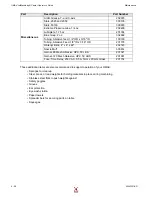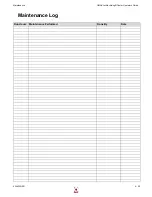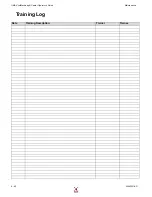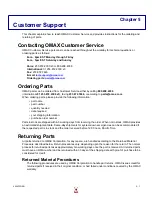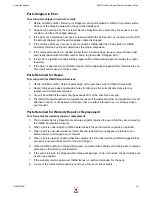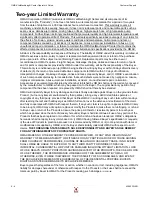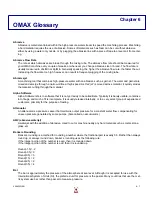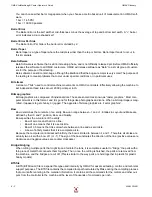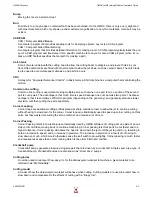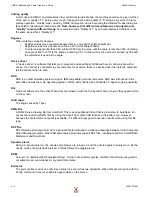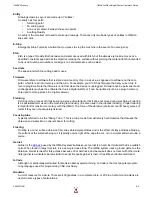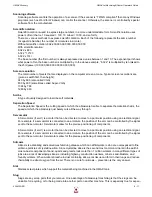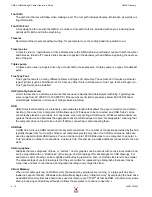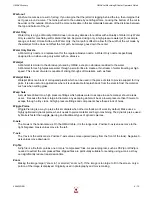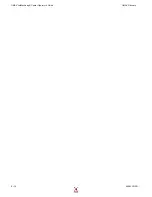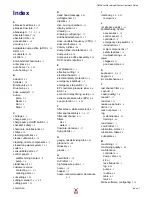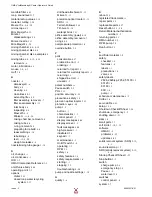
OMAX JetMachining® Center Operator’s Guide
OMAX Glossary
6 - 8
400433D-EN
Mesh
The coarseness of abrasive used. For example, 80 mesh abrasive is typical of most abrasive jet applications, but
120 mesh, which is a finer abrasive, might be used for special applications. Larger abrasives (smaller mesh num-
bers) cut faster, but produce rougher surfaces. The higher the mesh number, the finer the abrasive. An 80 mesh
abrasive will be about 177 microns in size, while 120 mesh will be about 125 microns.
MiniJet
TM
nozzle
The MiniJet nozzle is a replacement nozzle designed to produce small parts, or parts with intricate details. The
MiniJet nozzle fits on any standard OMAX machine.
Minimum Taper
The Minimum Taper Quality will adjust the speed of the machining head so that it creates the minimum amount
of taper (for metals) in the material you are using. In most cases, Minimum Taper will slow down the cutting
speed significantly--often to even slower than a Quality of 5. However, in some cases, where “reverse taper”
would otherwise occur, the cutting speed will be faster.
Mixing Tube
The mixing tube is part of the abrasive nozzle assembly. It is here that the abrasive, water, and air are mixed.
The mixing tube is made from a hard, brittle material, and is similar to glass. If the mixing tube is dropped or
strikes something hard, it can shatter. Although the mixing tube is made from an extremely hard material, with
time the flow of high-pressure water and abrasive will wear away the mixing tube. This causes a gradual widen-
ing of the mixing tube, which results in a wider, less accurate stream of abrasive and water. The mixing tube
should be replaced when tolerances drop below acceptable levels.
Muff
A muff is a protector that muffles the noise of the nozzle as well as lessens the effect of splash back. When prac-
tical, a muff should always be installed on the abrasivejet nozzle.
Nesting software
Nesting software arranges parts to get the maximum number of parts from a piece of material. Although nesting
software cannot do as well as a human can, it is considerably faster. It is also complicated and tends to do better
with parts that have simple shapes, rather than complex parts.
Nozzle
Usually, when someone says “nozzle,” they are either referring to the complete nozzle assembly (mixing tube +
Jewel + nozzle body and perhaps some plumbing.) Other times, “nozzle” is used as a synonym for Mixing tube.
Off-line Programming
Off-line Programming is the process of drawing parts and making tool paths on a computer that is not connected
to an OMAX. This is the preferred method for programming an OMAX because it does not tie up the machine
with tasks that you can do on a much less expensive computer.
Offset
The amount by which the abrasive jet nozzle is moved to one side of the tool path. An offset is needed because
the cutting jet is not infinitely thin, but has a finite width. By offsetting the nozzle to one side, precision can be
maintained. The offset is one-half the kerf.
OIR
The OMAX Interactive Reference is referred to as the OIR. The OIR is this series of interrelated files that pro-
vides a collection of information about OMAX software. Our goal is to have all the information in one location so
that you can quickly and easily find out what you want to know.
OMX file
The OMX file format is an updated version of the ORD file format. The OMX format supports movement in the Z-
axis (up and down), which can be programmed with the 3-D Path Editor for OMAX machines with a programma-
ble Z-axis.
Summary of Contents for JetMachining Center 2626
Page 8: ...OMAX JetMachining Center Operator s Guide viii 400433D EN ...
Page 12: ...OMAX JetMachining Center Operator s Guide xii 400433D EN ...
Page 22: ...OMAX JetMachining Center Operator s Guide Safety First 1 10 400433D EN ...
Page 140: ...OMAX JetMachining Center Operator s Guide OMAX Glossary 6 16 400433D EN ...
Page 144: ...OMAX JetMachining Center Operator s Guide Index 4 400433D EN ...

